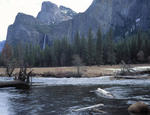Plague is a rare, but sometimes fatal, disease caused by the bacterium Yersinia pestis. It is primarily a disease of animals but can be transmitted to humans through the bites of rodent fleas or by direct contact with infected animals. Plague is considered endemic in northern Arizona at elevations above 4500 feet (1372 m). An average of 1-2 human cases of plague are reported each year in Arizona; the last human case in Arizona occurred in 2008. Grand Canyon visitors and residents should be aware that plague activity increases during summer months in the Southwest and take appropriate precautions to minimize risk of exposure.
Persons living, working, or visiting areas where plague is known to be present should take the following precautions to reduce their risk of exposure:
- Do not touch or feed wildlife, including rodents.
- Avoid exposure to rodent burrows, fleas and wild animals.
- Prevent pets from roaming loose.
- Control fleas on pets with flea collars or flea sprays routinely.
- Use insect repellant when visiting or working in areas where plague might be active or rodents might be present.
- If your job duties require you to handle sick or dead animals, wear appropriate personal protective equipment and consult an NPS wildlife veterinarian, as needed.
- Domestic cats and dogs are susceptible to plague. Pet owners should take their ill pets to a veterinarian for evaluation, as needed.


